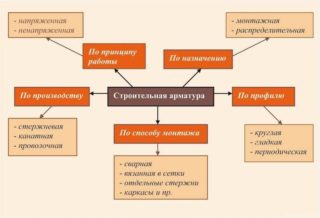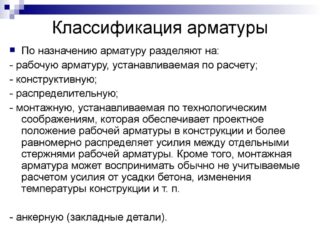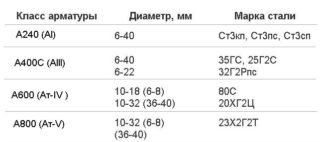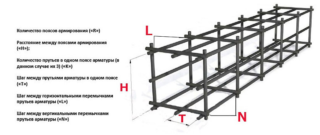A foundation located below ground level is the basis of any building structure. Several types of bases are known, the choice of which is determined by a number of factors. When arranging the foundation, it is imperative to use reinforced steel (reinforcing lattice). Before installing the frame, it is important to decide which reinforcement is suitable for a particular type of foundation and to understand the marking features.
Why do you need reinforcement for the foundation
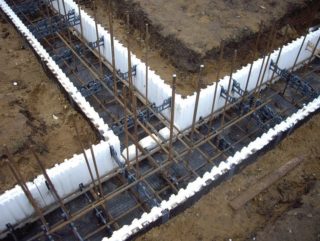
Concrete is a strong and durable building material that perfectly withstands compression, but is not sufficiently resistant to tensile and deforming loads. To improve the quality indicators of foundation structures, bar reinforcement is introduced into their composition, turning them into a symbiosis of metal and artificial stone.
The procedure for arranging the grounds:
- Formwork is prepared from wooden or steel panels.
- A reinforcing cage made of steel rods is installed in it.
- A concrete mixture is poured into the formed voids.
The completed building fully complies with the requirements of building codes. It is sufficiently strong and plastic, withstands extreme deformation loads (vibration, bending, etc.).
Classification
- manufacturing technology;
- steel grade;
- diameter of rods;
- physical properties of the metal.
After getting acquainted with the technical characteristics of the fittings, it is easier for a specialist to determine the scope of application of a particular product and the loads that it must withstand.
By the nature of the profile, well-known grades of reinforcing steel are divided into the following types:
- smooth fittings;
- corrugated rods with improved adhesion to concrete (rebars of periodic type);
- workpieces with bent ends, necessary for fixing in concrete.
This specification does not cover all existing types of reinforcement products.
Reinforcement types by purpose
- working grates and rods;
- distribution structures;
- assembly blanks.
The first type of products is well suited to tensile loads arising from their own weight and external influences. Structures of the second type ensure their uniform distribution and joint performance of reinforcing functions. Thanks to them, the rigidity of the entire frame increases, which prevents the displacement of individual elements when concreting the foundation foundation.
Mounting fittings are not designed to withstand longitudinal and radial forces; it is necessary for fixing metal rods within the formwork and no more.
The areas of application of steel products depend on their class and type (the latter are included in the designation of reinforcement). In accordance with these indicators, they are in demand in the following areas:
- production of foundations, ceilings and monolithic walls of low and high-rise buildings, industrial buildings, special-purpose structures;
- erection of supporting and protective reinforced concrete structures: supports for pipelines, greenhouses and columns;
- arrangement of screeds and strengthening of plastered surfaces;
- production of shaped reinforced concrete products: pipes, rings, floor slabs, as well as beams and foundation blocks;
- arrangement of road surfaces, sidewalks, runways, etc.
Reinforcing elements of a certain type and diameter are suitable for each application. Marking will help you choose the right product.
Rebar for strip foundations
The class A-III includes ribbed reinforcement, the steel grade in which is designated as A400 (it has a higher strength indicator). In addition, such blanks provide better adhesion to concrete and have a yield strength of 390 to 400 N / mm2. These indicators allow the steel rods to be stretched by 25 mm without breaking them, which is very important for vertical and transverse reinforcement and longitudinal strapping. The table of reinforcement classes contains all the necessary characteristics, including the weight and cross-section of the workpieces. According to European standards, steels with the designation A500C are used to maximize the reinforcement of the frame. When decoding the type of reinforcement in this case, it is taken into account that the letter "C" means the admissibility of welding the product while maintaining its physical properties.
Calculation of the required quantity
The basis for such calculations are:
- data on the structural features of the foundation;
- the value of the permissible loads on it;
- characteristics of reinforcement structures and welded lattice (its dimensions and the order of arrangement of rods).
The foundation calculated taking into account these remarks takes on the load from the entire building and distributes it evenly over the soil surface.
Even before starting the calculations, it is necessary to understand the structure of the load-bearing frame, presented in the working drawings and consisting of the following elements:
- vertical and longitudinal rods, located at an equal distance from one another;
- soft knitting wire, reliably tightening the lintels and vertical rods;
- special transition couplings connecting and extending individual elements.
For each type of foundation, its own reinforcement scheme and reinforcement profile are suitable, depending on the quality of the soil and the dimensions of the building, its design features and expected loads.

